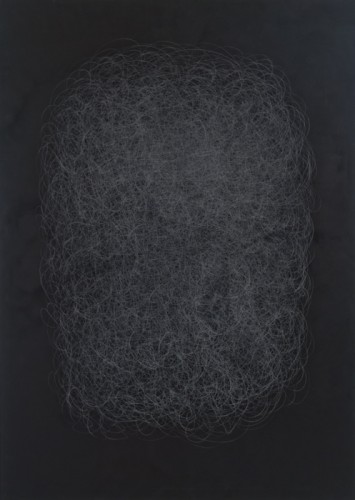
Tag: 2012
Haze
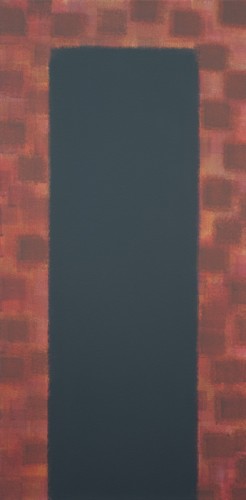
Immerse
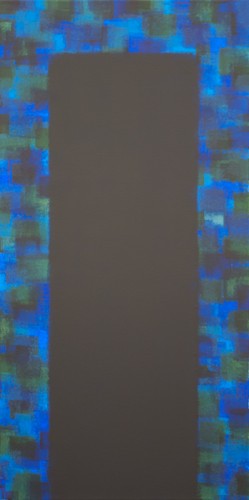
Dissolve
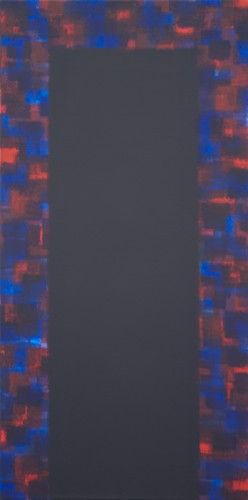
Fathom
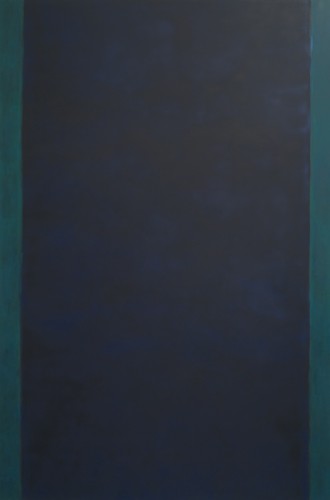
Threshold
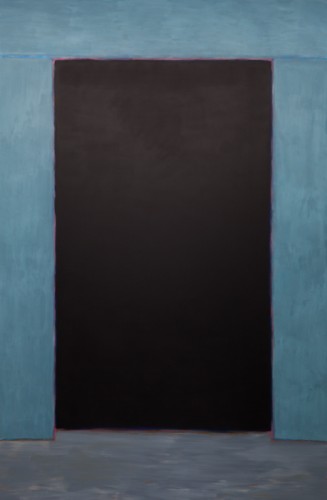
Craigie Aitchison
Craigie Aitchison died in 2009, and this show is intended as a memorial. The first surprise is that the white entrance at Timothy Taylor has been painted an appropriately intense red. The surprise continues inside, where the normally bright lighting of a white-walled gallery has been dimmed to gloom and spotlights pick out the paintings on the darkened walls. It has something of the feel of a church, the paintings treated as icons or altarpieces. And this is appropriate too, because one of Aitchison’s signature subjects was the crucifixion.
The first, from 1958, is on a panel smaller than a postcard, mounted upon a rough piece of wood. Small rusted nail heads recall the harshness of the cross, though the painting itself is gentle and luminous.
Luminosity of colour is a hallmark of these paintings, often a thin wash over a pale ground, or a thicker layer of bright colour; intense yellow in Shepherd, for example. Blue Handle Vase with Iris has a similarly vibrant orange ground to complement the blues of the vase, with the bright contrast of a green butterfly floating next to the pale iris. And in Sheep and Orange Tree, the tiny oranges sing out against a dark violet sky.
Aitichison’s was an economical style, and this is exemplified in a later Crucifixon II from 1967. The cross is flanked by two spindly orange-brown trees that seem like flames against the black ground. Christ’s features are sketched in with a few thin strokes, and the crown of thorns is made of just four thin pink lines. The whole image is minimal, but altogether enough to suggest the dark sadness of the event.
There are also portraits and landscapes here. The young girl in an extremely minimal portrait has the intense gaze of sitters in early work by Lucian Freud. Landscape with Mountain (Holy Island) is three large areas of colour: Prussian blue, mauve and sienna. The darkness is alleviated by a yellow-green halo behind the right-hand slope of the mountain. Seventeen years later, a very similar mountain stands in the background of the show’s final painting, the Three Kings contemplating the star.
These are paintings worth spending time with, and the whole show is a fitting tribute to this distinctive artist.
Michael Raedecker: volume
The paint is thin, washy. Drips and splatters everywhere. Grey, silver, one work in dark blue. Two in green. Looking at the one in pale pink, I thought of wedding cakes. And then, moving to my right, there they were: two cakes. But most of the work of the paintings is done not with painting or drawing, but by thread. Fine cotton thread, thicker wool. Single colours, braided yarns. In places the yarns have been twisted apart into tufted outgrowths from the surface. I want to touch them, feel their softness.
Houses, curtains, cakes, a chandelier; all are outlined with thread. Sometimes fine lines, single or in parallel. Elsewhere a garden bush is a small pile of overlapping lines of thread. Mostly they describe outline or contour. In pretend, the thread is just there, a bright multicoloured scribble stretching across the surface.
Then there are the holes. Smaller than your little fingernail, the broken threads of the canvas are exposed across the dark openings. It’s as if something has been eating through the surface. They seem incredibly fragile, these delicately stitched works.
Wide canvases are divided into panels vertically and stitched together. The houses are cut into fragments, partial frames from a drive-by movie. Who lives there? The chandelier doesn’t look like it belongs in these modest bungalows, but maybe the cakes do, or did. The closed curtains certainly do, keeping the world out.
Published in a-n magazine, May 2012
Turner and the Elements
Turner spent a lot of time in Margate, and this delightful show opens with a selection of local watercolours. Ramsgate from: The Ports of England is a small and finely detailed watercolour with ships, buildings and wave crests all carefully delineated. You can almost feel the weight of the water threatening to engulf the ship beyond the harbour wall. Margate, on the other hand, is a simple, almost minimal study in light washes with a few delicate clouds and a suggestion of sunlight on the horizon: no substance, just light and air. These works set out the range of what is to come.
The show is divided into two large galleries. One is devoted to the four traditional elements of earth, water, air and fire, while the other is entitled Fusion: a catch-all for a variety of works, mostly from later in Turner’s career. The elemental distinctions seem slightly artificial, especially when many of the works seem more concerned with colour and light than anything more substantial. But separating the works in this way does highlight one quality: Turner seems to have less affinity for earth than the other elements.
Some of the mountain landscapes certainly have grandeur, especially Yr Aran and Yr Wyddfa, a large watercolour of a Welsh mountain range, and Morning amongst Coniston Fells. But these seem heavy compared to Blair Atholl. Here, dark cloud and hillsides obscured by rain or mist give this work an atmosphere the others lack.
If Turner seems more at home with the lighter elements, he also seems awkward when dealing with the human figure. In Entrance of the Meuse, rather stiff, awkwardly drawn figures occupy pitching skiffs in the foreground and seem oddly unaffected by the turbulent sea, which is almost sculptural in its deeply scooped waves. In a later oil, Whalers, the seamen look almost model-like, oddly static amongst the energetic handling of the sea and sky around them. Figures in a Storm, an almost entirely blue watercolour study, serves to underline the point: the figures are more believable for being merely blocked in.
Most of the works here are watercolours, and there are some lovely examples of Turner’s handling of the medium. Stormy Sea, a postcard-sized work on blue paper, has vague suggestions of boats and shoreline below an intensely dark sky. Also on coloured paper is a lovely cloud study dominated by an ultramarine cloud bank, heightened with splashes of red. There are a number of cloud studies here, and the inevitable comparison is with Constable. His studies can seem like investigations of the structure of familiar cloud formations, but Turner’s seem more like excuses to experiment with colour and wash effects.
Another example of this is The Burning of the Houses of Parliament. Turner was there to see it in 1834, and must have had to work quickly. The work is almost a study just in using thin layers of red, blue and black, and detail of the buildings is largely absent.
All this watercolour work is very enjoyable, but the highlights come in the final room. There are seven large oil paintings here, two of which stand out. Snow Storm – Steam-Boat off a Harbour’s Mouth is a vortex of high waves, cloud and smoke, the boat’s distress rocket an explosion of thick white paint at the centre of swirling forces. If this is Turner maximal, Turner minimal is seen in Sunrise with a boat between headlands. A soft glowing light seems to emanate from the painting. Even with the gentle impasto of glittering sunlight, this oil is more like a watercolour study with its washes of colour, lightly-sketched headlands and the boat all but invisible.
With so many riches on display, this is a marvellous show. Almost all the works here are loaned from the Tate, but many were new to me and it’s well worth making the journey to see them. It’s an exhilarating demonstration of Turner’s range, curiosity and invention.
Published in a-n magazine, May 2012
Flow
